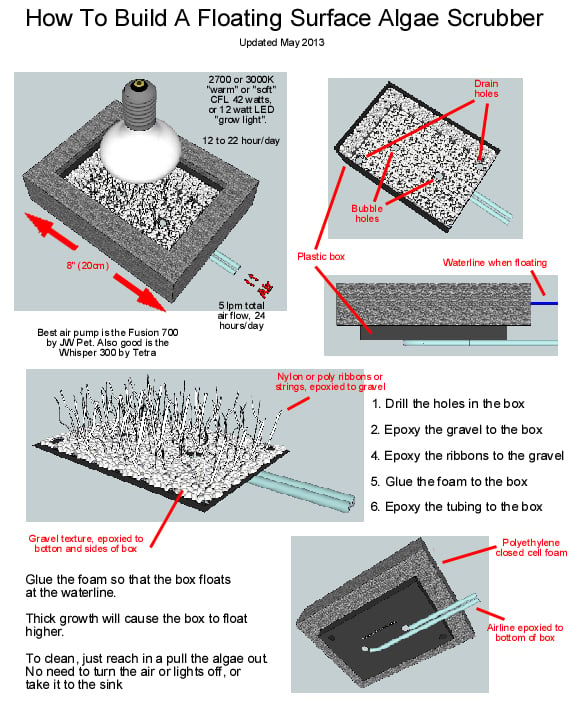What is Periphyton?
Periphyton is what turns your rocks different colors. You know... the white rocks you started with in SW, or the grey rocks (or brown wood) you started with in FW. After several months or years, the rocks become a variety of different colors and textures. Why? Because the periphyton that has grown on it is a mix of different living things, of different colors, and thicknesses. And the important part is: It is LIVING.
That's right: The colored stuff that has coated your rocks is all living organisms. Sponges, microbes, algae, cyano, biofilms, and of course coralline. After all, "peri" means "around the outside", and "phyto" means "plant". Ever slipped in a slippery puddle? That's probably periphyton that made it slippery. It's a very thin coating on the rocks, sometimes paper thin.
There is a lot of photosynthetic organisms in periphyton, and this of course means that they need light; but they need nutrients too (ammonia, nitrate, phosphate). And as you might figure, they will be on the lighted portions of the rocks. And they will grow to intercept food particles in the water, based on the water flow. Just think about how sponges orient their holes for water flow; the micro sponges in periphyton do it too but on a tiny scale.
What about under the rocks, in the dark areas? Well these periphyton don't get light, so they are primarily filter feeders. So they REALLY grow and position themselves to be able to intercept food particles. And they don't really need to fight off algae, because algae does not grow in the dark, so they have no need for anti-algae tactics like plants in illuminated areas have.
Reef studies have shown that at certain depths, more of the filtering of the water comes from periphyton and benthic algae than comes from the phytoplankton which filters the deeper water. And in streams, almost all the filtering is done by periphyton. So, what you have on rocks that are "mature" or "established" is a well-developed layer of periphyton; and all the things that comes from it.
This is why mandarin fish can eat directly off the rocks of an "established" tank (tons of pods grow in the periphyton), but not on the rocks of a new tank. Or why some animals can lay their eggs on established rocks, but not new ones. Or why established tanks seem to "yo-yo" less than new ones. Even tangs can eat periphyton directly when it's thick enough. Yes periphyton can also develop on the sand, but since the sand is moved around so much, the periphyton does not get visible like it does on rocks. So thick periphyton on established rocks is your friend. And totally natural too. Keep in mind though I'm not referring to nuisance algae on rocks; I'm only referring to the very-thin layer of coloring that coats the rocks.
But what happens when you "scrape the stuff off your rocks"? Well you remove some of the periphyton, which means you remove some of your natural filter and food producer. What if you take the rocks out and scrub them? Well now you not only remove more of your natural filter and food producer, but the air is going to kill even more of the microscopic sponges in it. And what if you bleach the rocks? Well, goodbye all filtering and food producing for another year. It's an instant reduction of the natural filtering that the periphyton was providing.
However, what if you just re-arrange the rocks? Well, some of the periphyton that was in the light, now will be in the dark; so this part will die. And some of the periphyton that was in the dark will now be in the light, so it will not be able to out-compete photosynthetic growth and thus will be covered and die too. And even if the light stays the same, the direction and amount of water flow (and food particles) will change; sponges that were oriented to get food particles from one direction will now starve. So since the light and food supply is cut off, the filtering that the periphyton was providing stops almost immediately, due only to the re-arranging of the rocks.
Starvation takes a little longer. The periphyton organisms won't die immediately, since they have some energy saved up; but instead, they will wither away over several weeks. So on top of the instant reduction in filtering that you get by just moving the rocks, you get a somewhat stretched-out period of nutrients going back into the water. And after all this, it takes another long period of time for the periphyton to build up to the levels it was at before: 1 to 2 years. Even changing the direction of a powerhead will affect the food particle supply in the area it used to be pointed at.
So a good idea is to try to keep everything the same. Pick your lighting, flow, layout, and try to never move or change anything. It's a different way of thinking, but you should have a stronger natural filter and food producer because of it.



